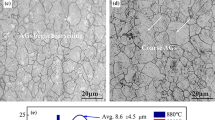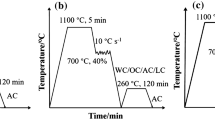Conclusions
-
1.
Steel 08Kh4N2M with the structure of lath temper martensite (σo η 2 = 700 N/mm2) exhibits a higher resistance to thermal embrittlement than steel 10KhSND with a structure of martensite and temper bainite. Steel 08Kh4N2M is recommended for use at operating temperatures to 350°C.
-
2.
The percentage of intercrystallite fracture reaches 48.6±2.6% in brittle zones of fractures in steel 08Kh4N2M in the refined state; this suggests the significant development of the phenomenon of reversible temper brittleness, which causes the boundaries of former austenite grains to weaken, during cooling in air after tempering.
-
3.
The development of thermal brittleness in steel 08Kh4N2m is accompanied by an increase in the percentage of intercrystallite failure in brittle zones, which correspond to the propagation of brittle cracks along the boundaries of former austenite grains.
Similar content being viewed by others
Literature cited
N. P. Mel'nikov, L. I. Gladshtein, V. M. Goritskii, et al., "Low-carbon martensitic chromium-nickel-molybdenum steel," Izv. Akad. Nauk SSSR, Met., No. 3, 112–119 (1983).
R. I. Éntin, L. I. Kogan, É. F. Matrokhina, et al., "The development and testing of lowcarbon martensitic steel for welded thin-wall housings for power units," Theses of Papers Presented at the All-Union Scientific-Technical Conference "Problems of the Development and Application of High-Strength Structural Steels" [in Russian], Moscow (November, 1983), pp. 31–32.
V. I. Bogdanov, S. A. Vladimirov, L. I. Gladshtein, and V. M. Goritskii, "Thermal embrittlement of low-alloy steel 10KhSND during prolonged holdings at 340–450°C," Probl. Prochn., No. 7, 65–73 (1976).
V. M. Goritskii and V. I. Bogdanov, "Comparison of the tendency to intercrystallite failure under conditions favorable to thermal and reversible temper brittleness," Collection of Papers Presented at the All-Union Scientific-Technical Conference "Intercrystallite Brittleness of Steels and Alloys" [in Russian], Izhevsk (1984), pp. 56–58.
V. I. Bogdanov, V. M. Goritskii, and Yu. I. Zvezdin, "Effect of phosphorus on the thermal embrittlement and characteristic features of the failure of steel 10KhNlM," Metalloved. Term. Obrab. Met., No. 12, 29–31 (1981).
Additional information
Central Scientific-Research Institute for the Planning and Design of Steel Construction. Translated from Metallovedenie i Termicheskaya Obrabotka Metallov, No. 8, pp. 21–23, August, 1988.
Rights and permissions
About this article
Cite this article
Goritskii, V.M., Shneiderov, G.V. & Bogdanov, V.I. Tendency of Cr-Ni-Mo steel to thermal brittleness. Met Sci Heat Treat 30, 585–588 (1988). https://doi.org/10.1007/BF00778262
Issue Date:
DOI: https://doi.org/10.1007/BF00778262




